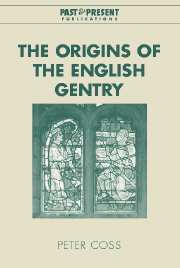Book contents
- Frontmatter
- Contents
- List of illustrations
- Preface
- 1 The formation of the English gentry
- 2 The roots of the English gentry
- 3 The Angevin legacy: knights as jurors and as agents of the state in the reign of Henry III
- 4 The crisis of the knightly class revisited
- 5 Knights in politics: minor landowners and the state in the reign of Henry III
- 6 Knighthood, justice and the early Edwardian polity
- 7 The explosion of commissions and its consequences
- 8 Identity and the gentry
- 9 Knights, esquires and the origins of social gradation in England
- 10 Crystallisation: the emergence of the gentry
- Appendices
- Bibliography
- Index
- Past and Present Publications
9 - Knights, esquires and the origins of social gradation in England
Published online by Cambridge University Press: 10 December 2009
- Frontmatter
- Contents
- List of illustrations
- Preface
- 1 The formation of the English gentry
- 2 The roots of the English gentry
- 3 The Angevin legacy: knights as jurors and as agents of the state in the reign of Henry III
- 4 The crisis of the knightly class revisited
- 5 Knights in politics: minor landowners and the state in the reign of Henry III
- 6 Knighthood, justice and the early Edwardian polity
- 7 The explosion of commissions and its consequences
- 8 Identity and the gentry
- 9 Knights, esquires and the origins of social gradation in England
- 10 Crystallisation: the emergence of the gentry
- Appendices
- Bibliography
- Index
- Past and Present Publications
Summary
One of the abiding characteristics of the English gentry has been its system of social gradation. And yet the origins of this system have received relatively little attention from historians. Of course, we are well used to describing a local society of knights and esquires in the fourteenth century and of accommodating the addition of gentlemen, albeit with some hesitancy, in the fifteenth. Historians have highlighted the sumptuary legislation of 1363, which points to the gentility of the esquire, and the Statute of Additions of 1413 which gives legal recognition to the mere gentleman. We may understand that neither piece of legislation is to be taken entirely at face value. Nevertheless they are recognised to be significant markers in the evolution of a graded gentry.
As to the highest gradation – that of the knight – we are now on relatively firm ground. We know that knighthood changed significantly in character during the early to mid-thirteenth century and that the rise of chivalric knighthood had a profound effect upon the elite mentality of the emergent gentry. Precise numbers continue to elude us, but even here we have a clear trajectory. Numbers were much higher at the beginning of the thirteenth century than was once thought and, indeed, a recent study by Kathryn Faulkner points to the existence of at least 4,500 to 5,000 knights in the counties during the reign of King John.
- Type
- Chapter
- Information
- The Origins of the English Gentry , pp. 216 - 238Publisher: Cambridge University PressPrint publication year: 2003

